1997-04-24 The Georgia Straight magazine, Vancouver, BC, Canada
by Shawn Blore
Pessimist give the world's tigers 5 years. Realists, 10.
They're the kind of numbers that make you want to quietly despair, to give up, to flip the channel and think about something more pleasant. Melrose Place maybe, or Roseanne. Anthony Marr, however, whether from a sense of conceit, ignorance, or a staggering sense of confidence, saw nothing impossible in the task of bringing the tiger back from the brink...
... To highlight the extent of Vancouver's tiger trade, Marr kicked off a media blitz in January 1996. Local journalists were invited on an endangered species tour through Chinatown's apothecaries. The tour began in the low-ceilinged warren that serves as Western Canada Wilderness Committee's headquarters. Marr upended his briefcase, spilling out 15-20 boxes of Chinese patent medicines: tiger plasters, tiger pills, tiger-based medicaments for rheumatism, tired blood, soft bones, and sexual impotence, all of them purchased in shops in Vancouver's Chinatown. Pointing to the ingredients lists on the diverse packages, Marr picked out the symbols, words, and phrases that in Latin, English and Chinese spelled out “tiger bone”.
The next part of the tour was a trip along Pender, Main and Keefer Streets, with Marr indicating here and there the shops and apothecaries dealing in tiger medicinals and inviting journalists to go in and check the shelves for themselves. Six shops out of 10 stocked a variety of boxes, cartons and bottles labeled with some variation of the word Os Tigris - tiger bone.
The media loved it. Marr made it on to TV news both locally and nationally, and stories appeared in city magazines and community papers. He used his pulpit to heap scorn upon Canadian wildlife regulations. “Canada's wildlife laws could use an aphrodisiac,' Marr said, “because right now, they're totally impotent.” He was equally hard-hitting in his presentations to Chinese community groups and at Eastside Vancouver high schools. Traditional Chinese medicine's use of parts of animals like tigers and rhinos, Marr said, and the cutting of many urban trees for that matter, were based on nothing but pure superstition. That superstition was destroying a magnificent species. The fact that the practice was tolerated by the Chinese-Canadian community only blackened their reputation in mainstream Canadian society.
Environmentalists heaved a sigh of relief. Here was someone tackling a problem they had long known about but dared not touch. “It's great that it's a Chinese person doing the work he's doing.” said Nathalie Chalifour, World Wildlife Fund Canada's tiger expert, “because when it's a person like me doing it, well, I'm white; I'm more likely to be accused to being racist, which is really unfortunate, but it does happen.”
Vancouver's Chinese media were as quick to jump on the story as their English counterparts. Marr's campaign was covered by both the Ming Pao and the Sing Tao newspapers, and he appeared on several Chinese language radio programs. According to Ming Pao columnist and CJVB radio host Gabriel Yiu, the Chinese community's reaction to Marr's campaign was mixed. His straight talk on superstition did offend some, but there was also those who took pride in the fact that a Chinese Canadian was working on environmental concerns. “For a long period of time when people are talking about monster homes, tree cutting, killing wild animals for some of their body parts,” Yiu said, “people do have the impression that the Chinese community is the cause of that. I think the work Anthony did set a very good example that we do have people in the Chinese community who are concerned about these issues.”...
According to Vancouver city councilor Don Lee, Marr's effectiveness was limited... “I don't know Anthony Marr that well. The Chinese Community doesn't know him well at all,” Lee said. “We don't know where he comes from. We don't know why he's doing all this.” As it turns out, those are two of the most interesting questions that could be asked about Anthony Marr..."

Most of my friends are Caucasian. Back in 1995, I had TV buddies of common interest, namely wildlife. Once a week or so, we got together to watch National Geographic over beer or tea (mine was tea). I loved these buddies of mine and these get-togethers, but there was often one thing that made me feel uncomfortable. Whenever an endangered species was touched upon and the Chinese use of animal parts in their traditional medicine was named as a cause of their endangerment, I would find myself on needles and pins due to my Chinese lineage, and became keenly aware that everyone else in the room was doing their best to try not glancing at me. Finally, when again it happened, I said, "Look at me. Tell me what you are thinking."
Ron, the most loud-mouthed of the bunch, cleared his throat and said, "I think it sucks. But we're honkies. We can't say a single word without being accused of racism."
Now I feel all eyes on me like lasers. I swallowed, hard, then said, "Alright, I'll do it." That was in the summer of 1995.
By November, I had checked out each and every one of the 33 traditional Chinese apothecaries for traditional Chinese medicine (TCM) containing endangered species ingredients. To my astonishment, I found highly packaged "patent medicines" galore, listing ingredients such as tiger bone, tiger penis, rhino horn, bear bile..., prominently displayed on shelves in all of the stores. I made a list of them, placing stars next to their names in terms of TV potential.
In the same period, I checked out Canadian law, and found a huge loophole that made it look like a joke. International law had it that no two nations could trade in any item containing endangered species part. And Canadian customs did check shipping containers from the Orient. But the Canadian government plainly stated that customs had enough man power to check only 2% of all the shipping containers, meaning that 98% of all illegal shipments simply slip right through, and the 2% discovered were simply confiscated, with a light monetary fine attached. The 98% that slipped through would enter Chinatown and be displayed for sale with impunity.
The reason for this is that there was no Canadian law governing the sale of these internationally illegal products once they have made their way into the country. It's like the Canadian government yelling to the smugglers, saying, "Hey, if you are smart enough to smuggle the stuff through customs, we'd allow you to sell it openly."
I thought hard as to how to Chinatown of these products, and concluded on two alternatives. One was to go into Chinatown and speak to the store owners to voluntarily destroy them, and to the Chinese people in Vancouver to not buy them. The other was to use media to blow the situation out to the public consciousness, which could press the Canadian government to create a law to ban the sale of such items anywhere within the country, such that the merchants would have no choice but to abide. The former looked to me like a pipe dream, and I settle for the latter.
By November, I was ready for action. At that point, I was just an unknown individual, and it was the subject matter that made the campaign so successful. I sent out media releases about my findings, and asked specific TV stations to come to Chinatown to document me openly purchasing endangered species products off the shelf. And no one turned me down.

[Anthony Marr in Vancouver Chinatown, 1995]
In one of these operations, I would have the TV camera parked across the street, but with the camera pointed down the street as if doing a tourism shoot. They would put a mic on me and I would walk right into the store, go straight to the shelf where the endangered species products were displayed, pick out a few samples, pay for them at the counter, and walk straight back out towards the TV camera, with the products in my hands, which I would show the camera close-up. By the time I had done all three of Vancouver's main TV stations, Chinatown had gone abuzz, and the TV-coverage had gone national. Activists from Victoria BC, Toronto and Ottawa ON, wrote me and asked me to do the same with their own Chinatowns.
I spent $100 to go to Victoria by ferry, but I did not have a deep enough pocket to fly across the continent at will. In December, I took my campaign to a few local groups, asking for their support. The one that came through, big time, was the 28,000-members-strong Western Canada Wilderness Committee, headed by founder Paul George, executive director Adrian Carr, and campaign director Joe Foy, all of whom I have seen on TV before. They sat opposite me across their conference room table, and pelted me with questions. After two hours of intense interrogation, over coffee, not only did they offer to support the campaign, but hire me on as their animal-issue campaign director. The pay was low ($25,000), no lower than what Paul, Adrian and Joe were paid, and I lept to the opportunity.

To make a not-too-long story short, came March, 1966, I received a personal letter from the then attorney general Sergio Marchi pre-informing me of the imminent passing of a new law acronymed WAPPRIITA, short for "Wild Animal and Plant Protection and Regulation of International and Interprovincial Trade Act". In April, it became law. By 1997, it was fully enforced.
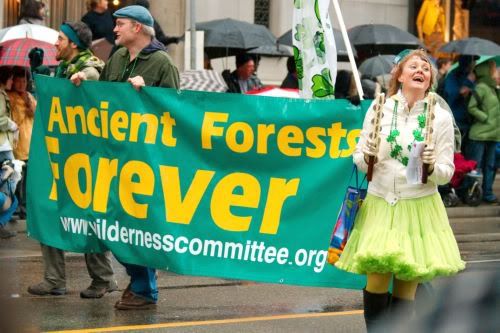
I stayed with WCWC until 1999, when I started my own organization Heal Our Planet Earth (HOPE), during which period I spearheaded WCWC's Bear Referendum anti-hunting campaign, later hailed as "the highest-profile wildlife protection campaign of the year in Canada" by the Global-and-Mail, Canada's pre-eminent national Newspaper, as well as went to India in 1997, 1998 and 1999 to work with the villagers living around the Kanha and Bandhavgarh tiger reserves, as well as to reform educational outreach and undercover operations in urban India including New Delhi, Calcutta and Jaipur. But these are other stories.
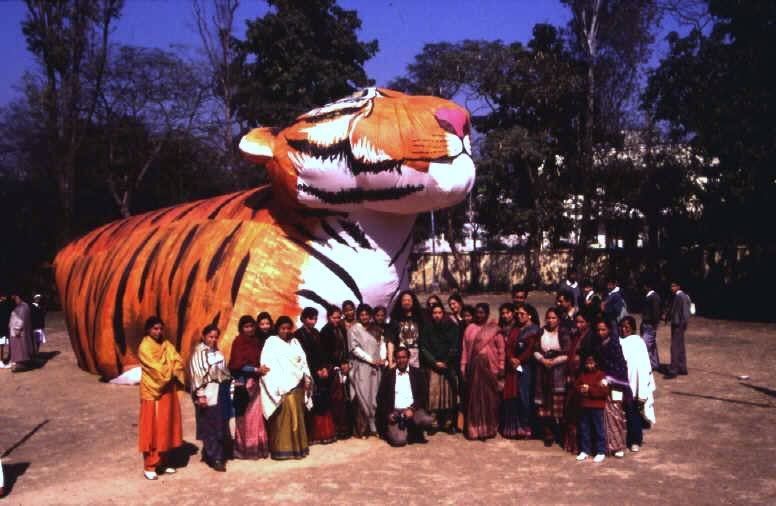
[Anthony Marr (center) speaking on tiger conservation in India]
Meanwhile the campaign rolled on, as outlined by the following media excerpts:
1995-12-02-6 The Vancouver Sun by Nicholas Read
[Animal parts for sale, and it’s legal]
"…‘The Chinese awareness is really not there," Marr says. "Maybe the only person you saw in Chinatown today who knows or cares about the plight of the tiger was me.’…"
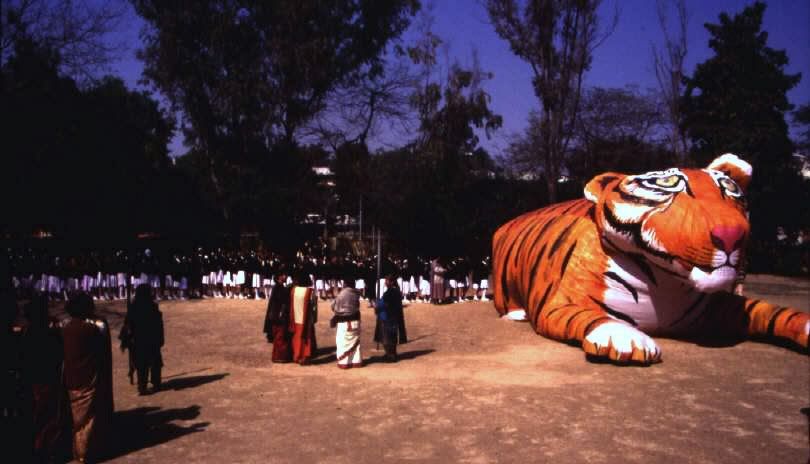
[Anthony Marr takes this opportunity to thank Evelyn Roth of Point Roberts WA, for donating this one of a kind inflatable tiger to WCWC for its education effort. Evelyn made this "big cub" Barabacha herself, with some help from Anthony Marr]
1996-01-08-1 Times Colonist, Victoria by Malcolm Curtis
[Tiger, tiger, put it right]
"… ‘If major endangered species of the world – bear, elephant, tiger, rhino – become extinct as a result of Chinese demand for their body parts, I would consider that a very serious crime against nature," Marr said in an interview…"
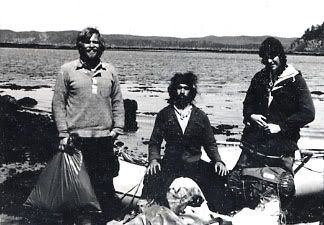
[Paul George as a young man]
1997-02-13-4 The Vancouver Sun by Anthony Marr
[Tiger, tiger, burning…out?]
"… If we commit to Gaia our heart and soul, our children may just see a new world emerge, one more compassionate than ever before, perhaps one destined for the stars."
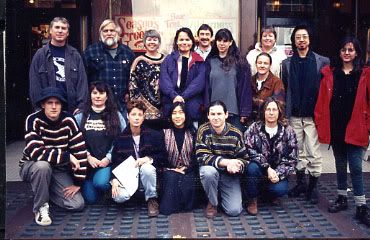
[Back row from left: Joe Foy, Paul George, Adriane Carr; and, 4th, 3rd and 2nd from right, Andrea Reimer, Sue Fox and Anthony Marr]
1997-03-19 The Hindu, Delhi, India
[In aid of the vanishing Bengal Tiger]
"Finally, the BET’R Campaign to save bears, elephants, tigers and rhinos has entered India as well…"
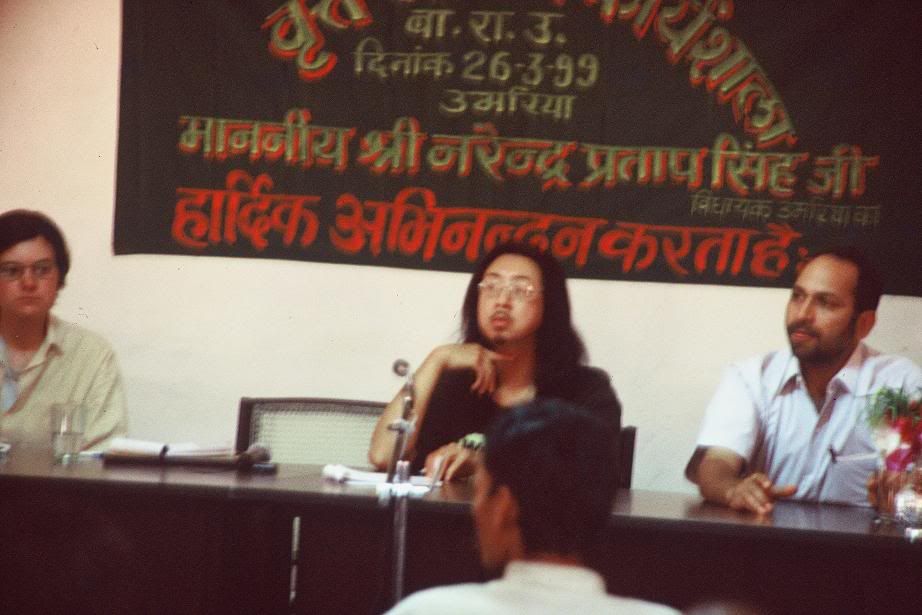
[Anthony Marr serving as keynote speaker at the 1999 Tiger Conference at the Bandhavgarh tiger reserve, Madhya Pradesh, India]
1997-05-08 The Georgia Straight, Vancouver by Roland Goetz
[Save tigers rather than saving feelings]
"… According to the article ([Bloody Superstition] - April 14), Garry Grigg of the Canadian Wildlife Service says, ‘We don’t want to be too heavy. We have got too many new Canadians here, and it takes a while to assimilate. We’re dealing with something that is thousands of years old.’
"My question is, would we allow other cultural practices, such as incest, clitoral mutilation, bestiality, or polygamy, to be imported into Canada?…
"… to save some feelings, we (may be allowing) a magnificent species to be destroyed."

[Adriane Carr]
1997-05-15
Korea Leads Illegal Trade in Bear Parts
LONDON -- (ENS) -
In a report released this week, an international coalition of wildlife organisations, including the London-based World Society for the Protection of Animals (WSPA), expose South Korea92s leading role in the illegal trade in bear parts. The report , "Killed for Korea" concludes that "South Korea and Korean people abroad represent the bear92s worst enemy after habitat loss."
Undercover film recently taken by animal campaigners shows Korean-sponsored bear poaching and gallbladder smuggling on an international scale as well as the killing of endangered bears for South Korean restaurant-goers.
The bears are desired for bear paw soup, a highly prized delicacy in South Korea. Diners will pay in excess of US$1,000 for a bowl of bear paw soup.
WSPA, together with the Korean Federation for the Environment Movement (KFEM), Humane Society of the US/Humane Society International (HSUS/HSI) and the Global Survival Network (GSN), is lobbying the US government to sanction South Korea over the illegal trade in bear parts. The organisations, with a total membership of over four million people worldwide, are considering an international boycott campaign of Korean goods, if their current approaches to Korean authorities are unsuccessful.
Andrew Dickson, WSPA chief executive, said, "Consumption of bear parts is a national disgrace for South Korea. We are trying to persuade the Korean authorities to stop this illegal trade which is pushing Asian bears towards extinction."
WSPA92s campaign is being backed by the Korean Federation for the Environment Movement (KFEM). Kwon Heanyol, spokesperson for KFEM said, "This outdated practice is a slur on our national reputation. It makes us look cruel and barbaric. Herbal, synthetic and Western alternatives exist for bear gallbladder. Why can92t all Koreans use these instead of continuing to torture and slaughter bears?"
Anthony Marr, organizer of Bears, Elephants, Tigers, Rhinos (BETR), a conservation group based in Vancouver, British Columbia confirms that South Korea is the world's leading consumer of bear parts.
Marr says, "South Koreans sometimes import black bears on the pretext of using them for zoo exhibits, then they have them killed in front of restaurant customers to prove authenticity and freshness."
Marr says he has read reports of caged bears lowered live onto hot coals to have their paws cooked. This procedure is supposed to guarantee freshness, authenticity and entertainment for the customer.
Marr has a video showing a 1989 restaurant menu from the posh Hilton hotel in Seoul offering "bear palm soup. Price - current."
Bear paws are considered a delicacy, not a medicinal, but bear gall bladders are prized for their medicinal effect.
The powdered bile taken from the bear galls has a whole range of uses, primarily for digestive healing and intestinal illnesses including parasites and bacterial infections. The powdered bile is used as an anti-spasmodic, a pain-killer, tranquillizer, an anti-allergenic, and a cough remedy. It is also considered to be a general purpose body tuning tonic. Bear bile is even said to restore a liver damaged by overdrinking.
Unlike tiger bones and rhino horns which have no real medicinal value, bear galls do contain ursodeoxycolic acid which does have a medicinal effect. This acid was patented as a synthetic in Japan in the 1930s. Today, 150 tons are used annually worldwide.
There are seven species of bears in the world, excluding the panda and koala, which are not considered to be true bears. Three bear species are endangered, particularly the Asiatic black bear, which used to be the main source of galls. The Asiatic black bear is now almost completely wiped out in China and Korea.
To meet the demand from Korea and other Asian countries, poachers have been taking bears from Russia and North America. Marr says poaching is "huge" in North America. Poachers have been caught in British Columbia recently, but provincial laws have no teeth, as the indigenous bears are not yet listed as endangered.
The penalty is very light when poachers are caught in B.C. Marr says, "Someone recently caught with 90 galls, which would easily sell for US$250,000 thousand in Korea, was fined $3,500 bucks, not even the price of one gall in Korea. For every batch of poached bear parts discovered by law enforcement officers, 49 get away. Customs officials estimate they can check only 2-3% of what goes out of Canada."
Marr estimates that between 20,000 and 40,000 bears are poached in Canada yearly. Legal trophy hunting kills 22,000 more.
In London, the WSPA is offering broadcast quality undercover footage showing the killing of endangered bears for South Korean diners and the farming of bears in China, some of which are destined for the Korean market
(From the Environment News Service: http://www.envirolink.org/environews/ens/)
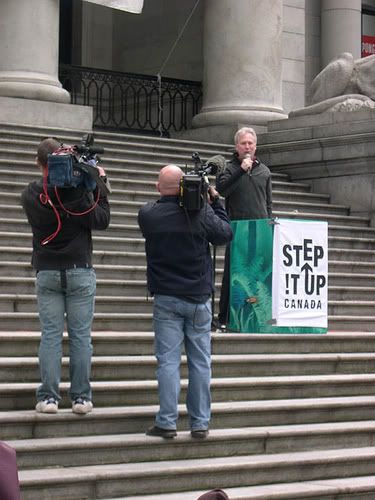
[Joe Foy]
1997-07-08 The Ottawa Citizen, Ottawa, Ontario by Finbar O’Reilly
[Animal activist targets Chinatown]
"… One Ottawa professor of traditional Chinese medicine, who asked not to be identified, said she abides by Canada’s laws banning the sale of tiger and bear parts, but that doesn’t mean she agrees with them.
"‘How come you have to protect the tiger, but not the cow?’ she asked. ‘I am a doctor. I want to treat people. If you care more about human than animal (sic), then why not use animal parts for safety?’…
"Mr. Marr, who plans a visit to the Chinatowns of both Toronto and Ottawa (to demonstrate that the new law) is not being properly enforced…"

[Anthony Marr speaking at the 1997 Save the Tiger Walk, Vancouver BC]
1997-07-11 The Toronto Sun by Tom Godfrey
[Tiger goods on shelf]
"… Toronto has become a hotbed for the sale of animal parts, including penises… said Anthony Marr…
"Marr said within an hour he was able to buy processed medicines containing or claiming to contain tiger bone, seal penis, deer penis…"

[WCWC's 1996 Bear Referendum campaign, spearheaded by Anthony Marr]
1997-07-15 The Globe and Mail, national by Michael Valpy
[The trade in seal and tiger parts]
"This is a Canadian story. Anthony Marr, a Chinese Canadian who lives in Vancouver, is sitting in a Toronto hotel restaurant waiting for a television crew.
"When the crew arrives, he will take its members to Toronto's Chinese community’s downtown commercial district on Spadina Avenue. Here they will wire him with a microphone and film him buying illegal tiger bone pills and legal, regrettably, seal penis pills…
"Mr. Marr says he has been embarrassed by all these practices…"

1997-10-01-3 News Leader, Burnaby, BC
[Gilmore students join efforts to "Save-the-Tiger"]
"… ‘Unless a huge conservation effort ignites now, the tiger will be extinct in the wild by the year 2004…’ said Anthony Marr… who gives the slideshows to the schools. ‘Some adults say, "How many tiger are there in Canada? Why should we be bothered? Go ask the kids.’…"

[Adriane Carr running for BC Green Party leadership]
1997-10-04-6 The Peace Arch News, Surrey, BC by Tracy Holmes
[Care for the cats]
"Save the tiger.
"That was the message students of Peace Arch Elementary received at a presentation by… Anthony Marr…
"Under the watchful eyes of a 50-foot inflatable tiger, the kids learned the only 4,000 tigers remain in the wild, and that some subspecies totaled less than the number of students in the gym.
"But, ‘I do not believe the tiger is doomed,’ Anthony Marr told the kids. ‘The reason I believe this is because nobody has ever asked kids like you to help out. If we can get kids around the world to say, ‘I want to save the tiger’, I believe the tiger will be saved.’…
"He also asked them to come to the Save-the-Tiger Walk at Stanley Park Oct. 18."

[Adriane Carr winning the BC Green Party leader race]
1997-10-08-3 The Vancouver Courier by Gudrun Will
[Students take tiger by the tail]
"High school environmental club rallies behind animal activist.
"An auditorium full of Kitsilano high school students roared in appreciation…
"Inspiring youth, Marr believes, is the only hope to save the rapidly diminished species…"
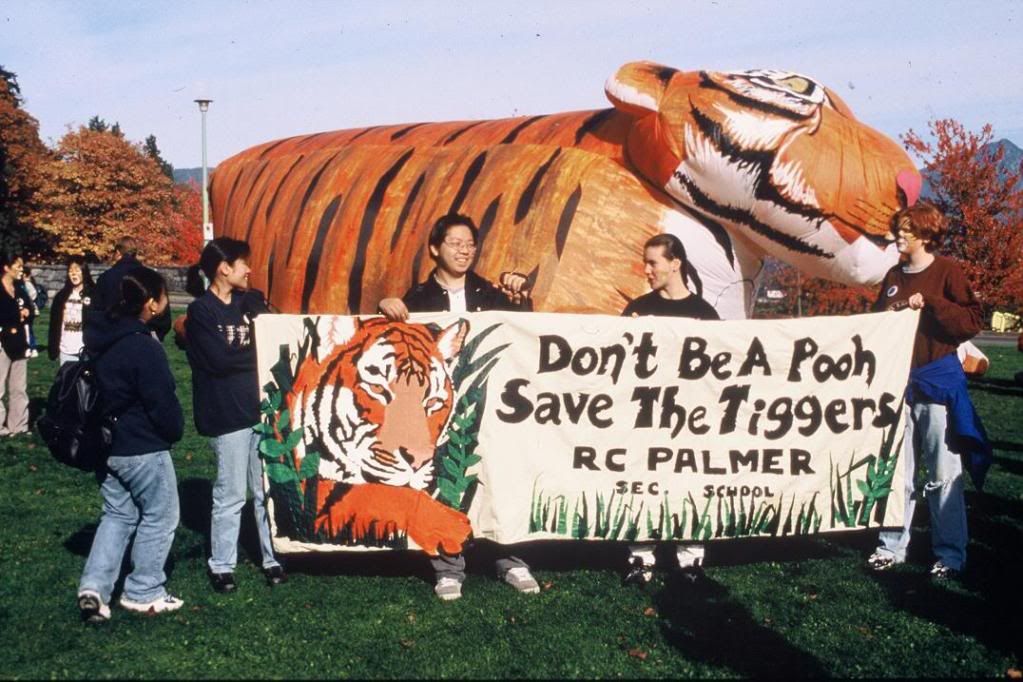
[WCWC's Save the Tiger Walk in Vancouver, 1997]
1997-10-16 The Westender, Vancouver
[Halloween fun, Tiger Walk set]
"… The WCWC has organized Save-the-Tiger Walk ’97…"
1997-10-19-7 The Province, Vancouver
[Walking for wildlife]
"Hundreds of concerned people took part in the ‘Save-the-Tiger Walk’ in Vancouver’s Stanley Park yesterday. They were walking to raise money to protect the dwindling number of tigers left in the wild."
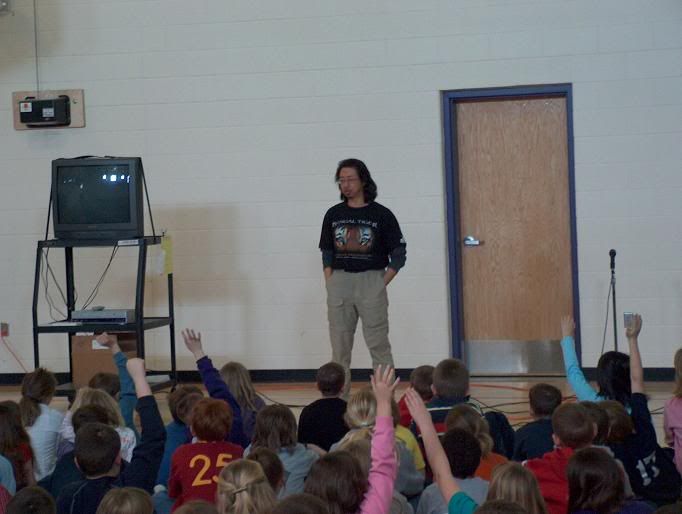
1997-10-19-7 Ming Pao Daily News (Chinese), global
[1,000 people walk to save 4,000 tigers]
"WCWC’s Save-the-Tiger Walk attracted over 1,000 children and their teachers and parents, and raised $20,000…"
1997-10-29-3 The Comox Valley Echo by Diane Radmore
[Service to remember animals]
"Animal lovers of all kinds are invited to come hear guest speakers and attend an outdoor gathering called In Remembrance of the Animals at noon Saturday, November 1, at the Sid Williams Foundation in downtown Courtenay…
"… Anthony Marr, initiator of the worldwide BET’R Campaign… will also be in attendance…"
1997-10-31-5 The Comox Valley Record by Diane Radmore
[Vigil for lost wildlife]
"Local activists to speak at downtown rally tomorrow…
"… Since last year’s referendum on bear hunting in BC campaign, Marr has been to India on behalf of the dwindling tiger population and was a guest speaker at last week’s International Fund for Animal Welfare Conference concerning the East Coast seal hunt…"
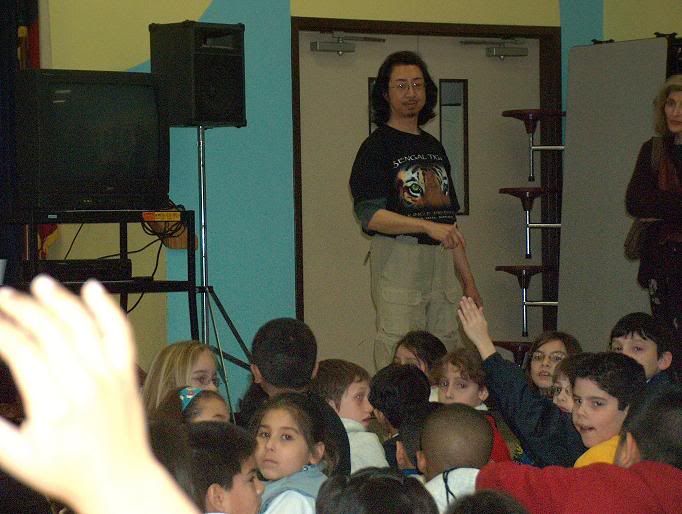
1997
New Internationalist magazine
Biodiversity Threat:
The traffic in endangered species for their skins,
organs, horns or as exotic pets is putting some of the
world's most vulnerable wildlife in dire peril.
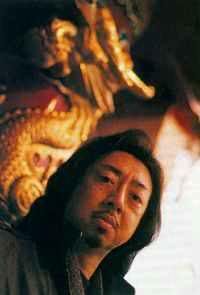
[New Internationalist cover photo of article]
Bad Medicine
by Ross Crockford
tells the story of a man who has stepped on toes
from Campbell River to Hong Kong to stop a pernicious trade
Anthony Marr knows what it feels like to be endangered. Last summer the Vancouver environmentalist was touring small towns in British Columbia, gathering signatures to force a referendum outlawing the hunting of bears in this Canadian province. Often the reception he got was downright hostile. Many people in the countryside claimed he was trying to destroy their livelihood and their heritage. ‘In Campbell River,’ recalls Marr, ‘a hunter pointed at me and said: “I saw you on TV this morning. The price on your head just went up $10,000.”’
Pretty frightening, but Marr has heard similar threats before, and often made in defence of a culture that is much, much older. Marr’s referendum drive was part of a larger, ongoing campaign (acronymed as BET’R) he has been running since November 1995 to stop the worldwide slaughter of bears, elephants, tigers and rhinos – big-game animals whose body parts are frequently used in traditional Chinese medicine. Marr is convinced that as Asia prospers and trade becomes further deregulated the demand for these animal parts will skyrocket.
Fortunately he’s in a position to do something about it. Since he was born in China and raised in Hong Kong, Marr figures he’s entitled to criticize things he grew up with that strike him as mere superstition. One is the belief that consuming part of a powerful animal gives strength to a corresponding part of your body. ‘When I was a kid my parents would give me things like bear gall and tiger bone as if it was aspirin,’ says Marr, who’s now 52. ‘Endangered species wasn’t part of my vocabulary at all.’
Consequently Marr spends much of his time speaking at Vancouver schools with large numbers of Chinese students, many of whom are hearing about the problem for the first time. He also speaks on Chinese-language radio talk shows. Sometimes listeners accuse him of defaming the Chinese reputation. Marr replies that, on the contrary, he is trying to save it: if we drive a species to extinction, he says, we can never regain respect in the eyes of the world.
‘A white person saying these kinds of things might be called a racist,’ says Marr. ‘But when a Chinese person is pointing the finger at Chinese culture, it’s more like self-examination.’
If public education is the long-term ‘yin’ of the BET’R campaign, the aggressive ‘yang’ is law enforcement. Until recently it was common to find rhino-hide and tiger-bone pills on the shelves of apothecaries in Vancouver’s Chinatown, and many did a brisk trade in gall bladders taken from bears poached in British Columbia and smuggled by individuals to Asia to sell for as much as $18,000 apiece. After a report by the Washington DC-based Investigative Network revealed the extent of the problem (one dealer offered a discount for 50 galls or more), law officers raided six businesses and seized 191 bear galls. Citing cases like this, Marr persuaded the Canadian Government to proclaim a Wildlife Trade Act, with penalties for traffickers of up to $150,000 in fines and five years in prison.
‘Chinese people are very pragmatic,’ says Marr. ‘They do things to produce results. They will abide by the law if the law comes down on them. Besides, if I work on the law I can affect all of the stores instead of just one of them.’
Not content to stop there, Marr then began the drive for a referendum to outlaw all bear hunting in British Columbia. Though the North American black-bear population is considered ‘healthy’ and the grizzly is classified as ‘threatened’, Marr argues that instituting such a ban when both species are endangered will be too late.
Hunters replied with death threats and racial insults, and obstructed and photographed people who wanted to sign Marr’s petition. In the end his volunteers managed to collect over 90,000 signatures – half of what was needed to force a referendum, but enough to argue convincingly that many wanted bear hunting stopped. Marr called on the provincial government to set aside more wildlife reserves, increase the penalties for poaching and ban the spring hunt, when most poaching occurs.
Now Marr is taking his BET’R campaign around the world. He plans to speak in several North American cities with large Chinese communities and after that in several Chinese-speaking capitals of the Pacific Rim. ‘There have been many articles crying for help, saying that what is needed is a person of Chinese extraction to tackle this problem,’ he says. ‘So here I am.’
Marr knows there will be some risk; organized crime is directly involved in the six-billion-dollar annual trade in endangered species, and it’s certain those involved will threaten him if they they think he’s jeopardizing their business. But after tangling with British Columbia’s hunters, he should be ready.
Ross Crockford is a freelance journalist working out of Vancouver.
©Copyright: New Internationalist 1997
1998-01-31 Sing Tao Daily (Chinese), global
[The next Year of the Tiger may see no more wild tigers]
"… Anthony Marr calls upon all Chinese, Japanese and Korean people around the world to stop using tiger bone, bear gall and rhino horn medicines…"
1998-01-31 Ming Pao Daily (Chinese), global
[Tigers may be extinct within one decade]
"… Anthony Marr speaks out from the Year of the Tiger booth at Aberdeen Centre…"
1998-02-24-2 The News, Parksville - Qualicum Beach, BC
[WCWC’s Bear Man returns to QB]
"Anthony Marr will be in Qualicum Beach next Tuesday, presenting slides of his two recent trips to India…
"Marr has stirred up a media storm…
"Marr will be ‘Champions of the Tiger’ in Omni-Film’s Champions of the Wild series on Discovery Channel this fall…"
1998-02-24-2 Comox Valley Echo
[Saving the Tiger theme for slideshow]
"… Please come out to witness the beauty of these magnificent animals and celebrate the ray of hope that Anthony brings us."
1998-02- The Free Press, Nanaimo, BC
["Champion of the Tiger" visits]
"The ‘Champion of the Tiger’ will share his story with Nanaimo…
"The slideshow starts at 7:30 p.m. at the Maffeo-Sutton auditorium… on March 5…"
1998-02-27-5 The Comox Valley Record
[Tigers in danger]
"WCWC hopes all to celebrate the Chinese Year of the Tiger with Anthony Marr…"
1998-03 Technocracy Digest by Bette Hiebert
[The Year of the Tiger - so, why are they killing them?]
"For money, of course…
"Anthony Marr… is on his way to challenge the East Asian destroyers in their lairs, to confront these people who are making millions killing these beautiful cats…
"Mr. Marr believes that if we commit to the Earth our heart and soul, our children may see a new world more compassionate than ever before. We hope he is right, but as long as there is the almighty dollar, there will be no compassion, and our children will see nothing but barren earth…"
1998-04-29 Ottawa Citizen, Ottawa, ON by Michael Den Tandt
[RCMP cracks down on trade in endangered animal parts]
"Toronto - The RCMP (Royal Canadian Mounted Police) and the Ontario Ministry of Natural Resources have taken a bite out of this city’s lucrative trade in endangered animal parts, a move conservationists say is long overdue…
"Asked whether (Viagra) may take some pressure off endangered species, Mr. Marr said… ‘If it doesn’t harm the environment, or any species, and it helps someone’s quality of life, then it’s a private manner.’
"He added, ‘I’ve seen one or two people on TV - and they really vouch for it. Including their wives."
1998-06-07-7 The Vancouver Courier by Gudrun Will
[Tiger volunteers paint mural to save species]
"On a scalding Wednesday afternoon, underwear clad painters dab tropical sunset colours on the front wall of downtown Davie Street hangout DV8. The artists are creating a tiger mural in preparation for a silent art auction to help save the species.
"... Organizer Tracy Zuber, a tiny 29-year-old in black sports bra and plaid shorts, is a self-professed tiger fanatic. Images of the wild animal cover her apartment walls. 'They're the personification of beauty, power and grace. They're a figurehead of primal life power,' said Zuber.
"Her preferred felines, however, are also a rapidly dwindling species; little more than 4,000 are left in the wild, and two are killed per day. Zuber was inspired to raise funds to slow down the tiger's beeline to extinction while participating in the Save-the-Tiger Walk last fall with her daughter Fija. The Year of the Tiger seemed an appropriate time to make an effort, she says......
"… conservationist Anthony Marr will present a slideshow that night…"
1998-09 The Vancouver Sun
[Champions return to Discovery]
"‘It took the tiger 10 million years to evolve to its present state of magnificence,’ says Anthony Marr, ‘but less than one century to fall to the brink of extinction. This, sadly, is the way of humans.’
"The Chinese-born Canadian is featured in the Bengal Tiger of India episode of the award-winning TV documentary series Champions of the Wild, now in its second season on Discovery Channel…
"Each episode highlights the efforts of a particular conservationist, from Clark Lungren’s work in the Nazinga Game Reserve, airing October 5, to Marr’s multi-faceted campaign to protect the tiger on October 12…
"Champions of the Wild was produced by Omni Film Productions, in association with the National Film Board, BC Film, and the Discovery Channel, with the participation of Telefilm and the Cable Production Fund."
1998-10-11-7 The Province, Vancouver by Jonathan McDonald
[Species run for their lives]
"Premier - Champions of the Wild - Mondays at 6 and 10 p.m. on Discovery Channel.
"… this 13-part series is only partly about the animals who are running for their lives. It’s mainly about the people - Canadians by and large - who are doing whatever they can to reverse increasingly hopeless situations.
"‘It’s vital,’ says Anthony Marr, a Vancouverite who heads the Tigers Forever campaign and is the subject of ‘Bengal Tigers of India’, which premiers Monday night on Discovery Channel. ‘The tiger is an icon of wildlife conservation. It is one of the world’s most admired and also most endangered animals. If it falls extinct, the whole global conservation effort will lose steam, and the world will lose an immeasurable amount of beauty.’
"Marr is not kidding. Seeing the Bengal tiger sleep, prowl and hunt is wondrous. Seeing the work of poachers - tiger skins and medicines - is no less than horrifying and offensive. And seeing Marr sit down in an Indian village to tell the children about the beauty of the tiger - an animal, he urges, that deserves to be on Earth - is the perfect reflection of Canadians’ work around the globe.
"‘They’re extremely dedicated,’ says Chris Bruyere, Champion’s producer… ‘Often, these are people who don’t believe there’s such a thing as fighting a losing battle.’…
1998-10-11-7 Ming Pao Daily News (Chinese), global
[Chinese campaigner saving 4,000 remaining wild tigers]
"The WCWC set up booth at the Vancouver Public Library Saturday to publicize tiger conservation, and will lead the Save-the-Tiger Walk at Stanley Park next Saturday…
"Anthony Marr says that of the original 8 subspecies of tigers, only 5 remain, totaling no more than 4 or 5 thousand, of which two die daily to poaching and other causes. At this rate, there will be no tigers left to celebrate the next Year of the Tiger…"
1998-10-18-7 Ming Pao Daily News (Chinese), global
[100 walk to save 4,000 tigers]
"… Last year’s Save-the-Tiger Walk brought out 2,000 people and raised almost $20,000 for tiger conservation. Unfortunately, this year’s Walk picked the worse possible time weatherwise. Only 100 people showed up to brave the heavy rain and high winds…"
1998-11-07 Toronto Sun by Michael Clement
[Animal Parts illegally sold here: activist]
"A west-coast wildlife activist alleges he purchased three bottles containing parts of endangered species, being sold illegally in a store in Toronto’s Chinatown yesterday…
"Marr asked reporters to accompany him to the Po Chi Tong Chinese pharmacy on Dundas St. W. yesterday where he purchased the three bottles. The bottles of pills purportedly contained bear gall bladder secretion, possibly from the endangered Asiatic Black bear, secretions from the musk gland of the endangered Musk Deer, and tiger bone, possibly from the endangered Bengal or Siberian Tiger, Marr said.
"‘Internationally, endangered species are totally forbidden to be traded, alive or dead, in whole or part,’ he said, adding that in June 1996 Ottawa enacted laws ‘forbidding the sale of anything containing endangered species parts.’
"‘The point of this exercise is to prove that the law is not being effectively enforced.’…"
1998-11-26-4 Nelson Daily News by Bob Hall
[Kids in the tiger’s grasp]
"Anthony Marr is touring area schools this week promoting the Save-the-Tiger campaign. With the help of the Nelson Youth Environmental group who put on a play of Dr. Seuss’s The Lorax followed by Marr’s slideshow… Wednesday morning, Marr talked to Hume Elementary School students in front of a 12 foot high, 50 feet long inflatable tiger prop. To bring further attention to the issue there will be a Save-the-Tiger Walk-a-thon this Saturday at Lakeside Park starting at 11 a.m. For more information contact the Nelson Eco-Centre."
1998-12-02-3 Trail Daily News by Lana Rodlie
[WCWC shares extinction fears with area students]
"… Bring the message about diminishing tigers to area schools, Anthony Marr is hoping to save the tiger, one child at a time…
"Pointing out how every living thing affect the life of something else, he asked the children, ‘How many cows do you think live in India?’
"Would you believe 350 million?
"Cows eat grass. Deer eat grass. Tigers eat deer. If the cows eat up all the grass, what do you think will happen to the deer, and the tiger?…
"‘Still, if you go into an Indian national park, you’re not allowed to touch anything, take anything, not even pick a blade of grass. But would you believe in a BC park, you are allowed to kill grizzly bears?’"
1999-02 Travel Talk magazine, India TT Bureau
[Save the Tiger campaign]
"… ‘A conscious effort has to be made to make the villagers aware of the hazards of deforestation, overgrazing and poaching, and their consequences on the whole ecological balance,’ said Marr.
"His Save-the-Tiger campaign has introduced new eco-friendly techniques for resource conservation, like solar cooking devices and biogas to wean the villagers from their dependence on wood-fuel…
"Marr also feels that the entry fee to the Indian wildlife sanctuaries should be raised manifold to benefit the locals of the area and also to maintain the reserves…"
1999-02-12-5 The Hindu, national, India
[Need to protect tigers stressed]
"… Mr. Marr, who is of Chinese extraction, is apologetic about the role of his country of origin in making the tiger a haunted animal… The Chinese make medicines out of tiger parts and, in the process, import as many as 300 dead tigers from India and Russia a year…
"Owning up to his birth country is the penitent Mr. Marr when he says that he is paying the penalty for his countrymen by campaigning (against the Chinese tradition)…
"… In the Pink City (Jaipur), Mr. Marr lectured to 2500 school children in three schools. In Delhi, he had a captive audience of children in 10 schools. He is convinced that children are India’s hope for its national animals the tiger…"
1999-02-14-7 The Asian Age, India
[Tiger walk today to save wild cats]
"… According to official estimates… tiger numbers have dwindled from 3,750 in 1993 to 3,000 in 1997. After the initial success of Project Tiger, the 90s have seen a drastic fall in tiger numbers. The tiger population in reserves around the country stands at 1,333 in 1995…"
1999-02-15-1 The Statesman, India
[A valentine for the big cat]
"An unusual ‘Valentine Day’ message was displayed by tiger enthusiasts in the Capital who went on a brisk march from Delhi Zoo to the head quarters of Project Tiger at Bikaner House, to spread the message of conservation.
"Children and adults held up banners for the ‘Love Tiger Walk’… (Organizers) pointed out that the largest cat n the world today has a mortality rate of two per day in the world and one per day in India alone.
"‘Especially as a tigress does not have another litter till her young can support themselves, ‘it is so much necessary to support the ones which are alive, as they do not breed rapidly like other species,’ said a child who participated in the march.
"A video show, an inflatable tiger blimp and presentations by eminent conservationists were some of the features of the march, which was supported (in part) by the WCWC."
1999-02-15-1 The Indian Express, India
[Tiger, tiger burning bright]
"A tiger balloon at the Love the Tiger Walk at the Delhi Zoo on Sunday…"
1999-02-15-1 The Hindu, national, India
[Valentines tiger lovers]
"… A team comprising Mr. Anthony Marr, campaign director of WCWC… has been making slide presentations, holding video shows and having interactions inside a 50-feet inflatable tiger balloon…
"They have been received with great enthusiasm by more than 5,000 students of various age groups. Painting competitions and slogan contests have also been organized as part of the campaign…"
1999-02-15-1 The Pioneer, national, India
[‘Save Tiger’ walk]
"Wildlife lovers walked through the busy streets of the national Capital on Valentine’s Day on Sunday to show their love for the tiger, which faces the threat of extinction…"
1999-02-15-1 The Hindustan Times, national, India
[Save the tiger]
"A 50-foot balloon tiger at the National Zoological Park to generate awareness among the masses for the conservation of the tiger…"
1999-02-16-2 Delhi Times, The Times of India, national
[He is no ordinary tiger]
"They sit inside it and discuss its decimation from the face of the planet. It’s 50-foot long and 12-foot high and is made of parachute material that can inflate. Striped bright yellow and black, this tiger was (brought to India) by WCWC for a Save-the-Tiger campaign to generate awareness on tiger conservation amongst school children…"
1999-03-18-4 The Hitavada ("The oldest and largest circulated English daily in Central India")
[Save tigers from extinction: Marr - Great mission: Anthony Marr educating children about protecting the majestic and beautiful tiger]
"… Mr. Marr who is tirelessly working in India… said that the tiger is the greatest national treasure of India, but even more so, it is a global treasure that is revered the world over. ‘Though it belongs to no individual, its loss would impoverish us all.’…
"… Mr. Marr said that the Royal Bengal tiger might look the most secure of all remain subspecies, but in truth, it is no more secure that the last carriage of a crashing train…
"Currently, Mr. Marr, along with (Canadian volunteer Anne Wittman) and… (Indian conservationist) Faiyaz Khudsar are battling to educate the people living around the Kanha (Tiger Reserve)…"
1999-05-10-1 The Vancouver Sun by Alex Strachan
[Rupert’s Land, Discovery shows win early Leos]
"… In television awards, Andrew Gardner won best writing in an informational series for a segment of Champions of the Wild featuring conservationist Anthony Marr and his efforts to draw attention to the plight of India’s Bengal tiger. Champion’s cinematographer Rudolf Kovanic was also cited for a segment about elephants…"
1999-6 TigerLink, India, global
[Love the Tiger Walk, Delhi]
"…The participants chanted slogans and sang a tiger conservation song lead by Mr. Anthony Marr, Tiger Campaign Director, WCWC…
"At Bikaner House the gathering was addressed by Mr. P.K. Sen, Director of Project Tiger, Mr. S.C. Sharma, Addl. Inspector General Forests (Wildlife), Angarika Guha, Class III student from Sri Ram Public School, Mr. Anthony Marr and Mr. Pradeep Sankhala, Chairman of Tiger Trust…"
1999-06-02-3 The Daily New, Nanaimo, BC by Valerie Wilson
[Students learn plight of the tiger]
"… Anthony Marr… warns tigers are disappearing at al alarming rate. He is in Nanaimo this week to ask area school children to save the tiger from extinction.
"‘Your voice is important and you must speak out,’ Marr told students of Uplands Park Elementary Tuesday. ‘You are very powerful if you want to make some changes in the world.’
"Marr has been back in BC for about a month, after a 10 week working stint at tiger reserves in India. He brought home with him a breath-taking slideshow of the country’s landscape, tree and plant life, birds and animal life, and of course, photographs of the tiger he viewed at India’s Kanha, Bandhavgarh and Ranthambhore tiger reserves.
"‘A question I am asked often by adults is there are no tigers in Canada, so why should we be bothered.,’ Marr told student.
"‘Very simply. The tiger is one of most beautiful animals in the world. If it becomes extinct, our world would be much less beautiful place. We all lose.’.."
1999-06-07-1 Nanaimo News Bulletin by Erin Fletcher
[A tale of 4,000 tigers]
"Children hold the key to the survival of the endangered tiger, says tiger conservationist Anthony Marr…
"To spread the word about the plight of tigers, Marr was visiting Nanaimo schools last week with a slideshow presentation, video, and a discussion in the hopes to stimulate an interest in tiger preservation among local youth.
"Marr has been involved with tiger conservation since 1994. His passion takes him into the depths of India where he works to educate and promote the preservation of tigers…"
1999-06-10-4 Nanaimo News Bulletin by John Kimatas
[Chamber picks city’s top citizens]
"… Having won a scholarship this year, (Madeline) Hargrave says she’ll probably study at Malaspina University-College for a year. But after hearing Anthony Marr speak at a Global Watch function about the plight of tigers in India, she’s considering traveling to India to help him save the tiger.
"Otherwise, she is unencumbered by limitations. ‘I want to do everything,’ she says."
1999-08-02-1 Associated Press, New York City by Katherine Roth
[Despite tougher laws, tiger bone still widely available in Chinatown]
"… As of Monday, the products were still prominently displayed on the shelves of some pharmacies and grocery stores (in New York City's Chinatown)…
"‘It’s very popular and is good for people with bad backs,’ a smiling clerk at Kam Man Food Products on Canal Street told shoppers on Monday. ‘I don’t take it, because I don’t have a bad back, but a lot of people do,’ said the man, who declined to give his name or comment further…
"Anthony Marr… said that of the 37 traditional Chinese pharmacies visited in Chinatown recently, nine were openly selling products listing tiger bone as an ingredient. He is calling for stiffer penalties for sellers and importers who break the law…
"But the US Fish and Wildlife Service… says it doesn’t have enough resources to stop the brisk trade…
"‘We have 93 inspectors and 230 special agents for the entire country. They’re stretched pretty thin,’ said Patricia Fischer, a spokeswoman for the agency. ‘The sheer volume of wildlife products coming into this country present a monumental task…’
More than 50,000 over-the-counter tradition Chinese medicines containing, or purporting to contain, tiger bone and parts from other critically endangered species are sold in the United States each year to people of all ages and ethnic groups…"
1999-08-03-2 Daily News, New York City by Laura Seigel
[Tiger bone Rx selling in the city despite ban]
"At a cramped grocery in Chinatown yesterday, a casually dressed man plunked down $3.95 and was handed an alleged arthritis cure - tiger bone bills.
"Anthony Marr, the Chinese-Canadian tiger campaign director of WCWC in Vancouver, said the purchase proved a grim fact that he had traveled to New York to demonstrate:
"The law against selling medicine made from the bones of tigers, an endangered species, is not being enforced.
"‘I’m here in New York to persuade the government to enforce the law,’ said Marr. ‘Tigers will be extinct within 10 years unless things change.’
"A spokeswoman for the federal Fish and Wildlife Service, which is responsible for monitoring the sale of tiger bone medicine, conceded the agency could do a better job. ‘But we don’t have the staff,’ Patricia Fisher said. ‘We only have 230 special agents for the entire country.’
"She said the agency has tried to control the sale of tiger bone by teaching Asian communities about endangered species, rather than by enforcing the law without explaining it. ‘This is a tradition in Oriental medicine that goes back centuries,’ Fisher said…"
1999-08-03-2 World Journal (Chinese), global
[The ‘Long March’ of a Chinese-Canadian conservationist]
"… Marr arrived in New York City last Friday. On Saturday, he conducted a reconnaissance of Manhattan’s Chinatown district with some local help. In one sizzling afternoon he investigated 37 medicinal stores, and found at least nine that still openly displayed tiger bone medicines for sale…
"Yesterday, after a brief media conference in which Marr gave a slideshow on tiger conservation, he led the media present to three of the nine stores to perform demonstration live-purchases…’
"Shop keepers interviewed seemed aware of the illicit nature of the product, but said since most tigers in China have been killed off, the tiger bone medicines they sell probably contain no real tiger ingredient…
"The new Rhino and Tiger Product Labeling Act of 1998, however, ban any product claiming to contain tiger or rhino parts, whether or not they actually do…"
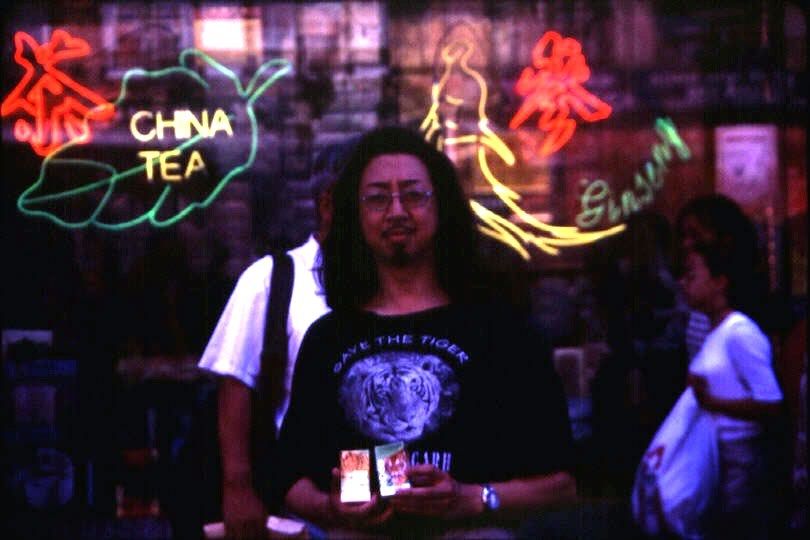
[New York Post newspaper article cover photo]
1998-08-12-4 Reuters News Agency by Manuela Badawy
[Import of tiger bones a problem in U.S.]
"…’At today’s rate of poaching tigers will be extinct in a decade. Tigers don’t have the time to wait for the Chinese community to change its habit,’ said Marr, who is of Chinese descent and has taken heat from other Asian for his campaign.
"On a recent day, he led journalists to New York’s Chinatown, which has one of the largest concentrations of people with Chinese background in the United State, to buy supposedly banned tiger elixirs.
"At the Golden Spring pharmacy on the Bowery in Lower Manhattan, Marr walked right in and bought a vial of Tiem Ma tiger bone pills for $3.95. Tiem Ma pills, made by Guiyang Chinese medicine factory in China, listed 6.8 percent ground tiger bone as one of its ingredients and claimed to treat rheumatic neuralgia, lassitude of tendon and back pain.
"When journalists and photographers went into the store after Marr purchased the pills, clerks became visibly anxious, removing the pills from the counter and shoved them into a box. They refused to answer journalists’ questions…"
1999-08-21-6 The Toronto Star by Manuela Badawy, Reuters
[A helluva town for tigers]
"… Under the 1998 Rhino and Tiger Products Labeling Act …people caught with these products face a fine of $5,000. Business owners pay $10,000 and/or get six months in jail.
"In comparison, fines for seal penises are $100,000 for individuals and $200,000 and/or one year in jail for business owners.
"Marr says the fines for tiger violations should at least equal that for seal violations, if only because the tiger is critically endangered…"
Being a long-time Bengal tiger preservationist, Anthony Marr has developed the popular and ever-evolving 280-image Tigers Forever slideshow which has been shown to over 150,000 people on three continents. He will also give this slideshow on this speaking tour, upon request. "Of the original 8 tiger subspecies, 4 have already gone extinct, and the other 4 will soon follow, unless the entire world rallies to its cause without delay. The tiger is one of the most revered animals on Earth. If we can't even save the tiger, what can we save for our children's children?" said Anthony.
On Anthony Marr's
Tigers Forever Presentation
from Michael Statham
Headmaster,
Central Okanagan Academy
"Mr. Anthony Marr's presentation to our students was not only educational and enlightening, but our students also found it mesmerizing. Mr. Marr is a seasoned and inspiring speaker who kindly brought his message of the tiger's plight to our students. We booked two sessions: one for our primary department, grades K-3 and the second for our students in grades 4-8. He tailored his speech and presentations to their individual needs, ensuring they were age appropriate. As a scientist, teacher, philosopher, environmentalist, and photographer, Mr. Marr is able to impart his passion in a powerful manner. Addressing his audience with fervor, accompanied by a stunning slide show, Mr. Marr captured our student's attention from the outset. This did not diminish as the presentation proceeded. I suppose the test of any such endeavor might be measured in the quantity and quality of the questions asked by the students upon its completion. Suffice to say that Mr. Marr did not charge for the overtime he incurred while answering each and every student who had a question. He did so with patience, wit, humour and more importantly, deep knowledge and conviction. A Student Council member asked him what specifically they could do, as a Student Council, to help save the tiger. His response to her was an earnest one. " Try to really understand what you have seen and heard today. Then, make others around you aware. In this way, the message grows." This response was heeded and our Student Council has now formed a "Green Team" and is hosting a "Save the Tiger Day" at the school to raise funds. Not only did his presentation inspire our Student Council, but the older students also used this experience to write poetry and prose, and our primary students in K-3 have performed songs, written stories, drawn and painted in sharing their thoughts and feelings. Was the experience a positive one? Absolutely. Would I recommend it? Without hesitation."
San Francisco Chronicle
Bile Trade
Teresa Castle, Chronicle Staff Writer
Monday, April 25, 2005
The world's appetite for bear bile and bear parts extends to the Bay Area and has even led to the hunting and killing of California's wild bears, state officials and animal rights activists say.
Lt. Kathy Ponting, field supervisor for the California Department of Fish and Game's undercover Special Operations unit, says game wardens regularly find black bear carcasses in the wild with only their gall bladders and paws cut away.
When WildAid, an animal rights group based in San Francisco, sent an undercover investigator into Chinatown last year, two shopkeepers readily offered up vials in velvet-lined boxes with a picture of a bear on the lid, claiming the powdered bear bile was from farms in China, said Executive Director Peter Knights.
One reason wild bear parts are prized is that some adherents of traditional Chinese medicine believe that by eating animal parts, they will take on the characteristics of the animal. Yet because California law bans the sale or purchase of bear parts -- with penalties ranging up to a $30,000 fine and three years in state prison -- the trade is clandestine and it is impossible to gauge the full extent of the problem.
But in 2001, when the World Society for the Protection of Animals conducted a probe of traditional Chinese medicine shops in Canada and four U.S. cities -- Chicago, New York, Washington and San Francisco -- it found that 91 percent of the shops surveyed sold some form of bear part, including farmed bile powder, bile medicines and whole gall bladders.
In San Francisco, bile crystal sold for $50 a bottle, the survey found, and whole gall bladders, which the merchants claimed to be from wild bears in China, sold for $129.
The Humane Society of the United States says smugglers have been caught with bears' gall bladders dipped in chocolate, in an attempt to disguise them as chocolate-covered figs, and packed in coffee to conceal the smell.
Knights said demand for the once-rare product remains high, which has led to more bears being killed in the wild. "People don't want to be like a bear in a cage, they want to be like a wild bear," Knights said.
Some users of Chinese medicines argue that Westerners have no right to criticize their centuries-old cultural traditions. But Anthony Marr, a Chinese Canadian animal welfare advocate, argues that "all traditions, sooner or later, have to give way to new advances, and for this practice, its time has come."
Another reason that wild bear parts are in demand is that consumers grew wary of prepackaged bear products after the state's Department of Fish and Game revealed that some "bear" products netted in sting operations were really from pigs and cows. Poachers sometimes go to great lengths to prove their bear parts are real, even videotaping the kills in some cases, Knights said.
In the mid-1990s, the Department of Fish and Game aggressively pursued bear poachers and held meetings with experts on the trade in bear parts. A yearlong sting operation in Kern and Tulare counties dubbed Ursus III netted 11 suspects in 2003.
Sting operations have helped tamp down the trade in certain areas, Ponting said, but she added: "We would be naive to feel we have it in check.''
State efforts were curtailed under Gov. Gray Davus when the Special Operations unit was cut from 10 wardens to six. The hiring freeze was lifted in July 2004.
"I wish we had the resources to do more," she said. "We're just spread so thin. We've got a lot of species to protect."
Tracing poachers is complicated by the fact that there is no uniform federal law banning the trade in bear parts, so poachers can transport their contraband from California to one of the eight states where the parts can be bought and sold legally. A number of bills have been introduced to put a federal ban in place, including bills by Rep. Elton Gallegly, R-Thousand Oaks (Ventura County), and Sen. Mitch McConnell, R-Ky., but so far they have stalled in Congress.
Ponting said she believes the major market for poached black bear parts is in California, with its large Asian population: "The supply and the demand are right here."
Miles Young, a former supervisor for undercover Fish and Game operations, suspects that many California bear parts are making their way to Asia. "Galls are worth a lot more going to Asia," said Young, who retired from the department in December 2003.
The trade can be lucrative, he said, especially for international smugglers. During one sting operation, he sent an Asian woman to buy gall bladders from poachers in Northern California. She was able to buy 35 in one day, paying $35 to $40 for them, he said. Agents then resold them to a Bay Area merchant for $300 to $400.
"You can add another zero to that to get the price in Korea," Young said.
Knights, from WildAid, says efforts to crack down on poachers are worthwhile.
"If you bust somebody and publicize it, the aftershocks can last for years."
But his organization is taking another tack, attempting to make the trade in animal parts unfashionable and to persuade consumers to use alternatives, like synthetic bile and herbal remedies.
The group has filmed television spots featuring Asian and international celebrities such as martial arts actor Jackie Chan, director Ang Lee and actress Michelle Yeoh. The spots have been broadcast to an audience of more than a million people a week, mainly in Asia.
Their tag line: "When the buying stops, the killing can too."
E-mail Teresa Castle at tcastle@sfchronicle.com.
Page A - 8
* * *
Anthony Marr, Founder and President
Heal Our Planet Earth (HOPE)
Global Anti-Hunting Coalition (GAHC)
Anthony-Marr@HOPE-CARE.org
www.HOPE-CARE.org
www.facebook.com/Anthony.Marr.001
www.facebook.com/Global_Anti-Hunting_Coalition
www.myspace.com/AnthonyMarr
www.youtube.com/AnthonyMarr
www.HomoSapiensSaveYourEarth.blogspot.com
www.myspace.com/Anti-Hunting_Coalition
www.ARConference.orgThanks
1 comment:
Anthony,
I know of no one more tenacious, unrelenting, dedicated and steadfast than you. Not many people would face-off with a roomful of 100 angry hunters but you did...40 times. And now, as you prepare to assist with anti-hunting referendums in the States, you again display your "never give up" and never back down" attitude that is always so encouraging to the activists who look to you for your leadership and experience. Anthony, you are a hero and a legend in the anti-hunting movement. As you express your gratitude this holiday season, we activists express our gratitude to you...for always staying true to who you are.
Much love,
Catherine
Post a Comment